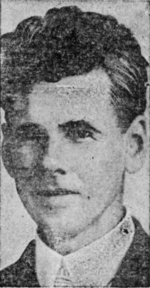A. S. Embree
A. S. Embree | |
|---|---|
 | |
| Occupation | Labor leader |

A. S. Embree was an American union organizer, Christian minister, and, leader in the Industrial Workers of the World (IWW).[1] Embree served as the secretary-treasurer pro-tem of the national IWW for a period of two months after the national office was raided by federal agents.[2][3]

Embree was the editor of the Nome Industrial Worker in Nome, Alaska and chairman of the Bisbee, Arizona IWW strike committee.[4] He was among the union men deported during the Bisbee Deportation, July 12, 1917. He later returned to Bisbee, and was arrested on a charge of inciting a riot. After a change of venue, he was tried in Tucson, and acquitted minutes after testimony was completed.[5][6] Embree then again returned to Bisbee, and was jailed for three months, and threatened with lynching if he did not leave for good.[7]
Embree sought relief from the federal government, arguing that he had the right to live with his wife and children wherever he chose. The federal government informed him that they saw no grounds on which to intervene.[8]
He then worked as an organizer in Butte, Montana, and then traveled to Idaho, where he was arrested for making speeches and distributing literature for the IWW.[9] Embree was convicted of violating Idaho's Criminal Syndicalism Act in Shoshone County in 1921, and spent more than three years in jail.[10] After he was released, he began organizing coal miners in Colorado in March 1926, focusing in particular on Walsenburg, Colorado.[11]
The subsequent strike involved a statewide walkout of twelve thousand miners. The strike is best known for the Columbine Mine Massacre.[11]
In August 1939, Embree was working as an organizer for the International Union of Mine, Mill, and Smelter Workers (IUMMSW) in Silverton, Colorado. He and the secretary of the Silverton local were forced into an automobile and deported. The National Labor Relations Board stepped in and ordered back pay for miners who had also been evicted.[12]
Footnotes[edit]
- ^ Gibbs M. Smith, Joe Hill, Gibbs Smith, 1969, page 117
- ^ Stephen Martin Kohn, American political prisoners: prosecutions under the espionage and sedition acts, Greenwood Publishing Group, 1994, page 170.
- ^ Mining and scientific press, Volume 122, Dewey Pub. Co., 1921, page 789.
- ^ Stephen Martin Kohn, American political prisoners: prosecutions under the espionage and sedition acts, Greenwood Publishing Group, 1994, page 170.
- ^ Mining and scientific press, Volume 122, Dewey Pub. Co., 1921, page 789.
- ^ Philip Sheldon Foner, Labor and World War I, 1914-1918, International Publishers Co, 1987, page 278.
- ^ Philip Sheldon Foner, Labor and World War I, 1914-1918, International Publishers Co, 1987, page 278.
- ^ Melvyn Dubofsky, Joseph Anthony McCartin, We Shall Be All: A History of the Industrial Workers of the World, University of Illinois Press, 2000, page 222.
- ^ Mining and scientific press, Volume 122, Dewey Pub. Co., 1921, page 789.
- ^ Stephen Martin Kohn, American political prisoners: prosecutions under the espionage and sedition acts, Greenwood Publishing Group, 1994, page 170.
- ^ a b Jonathan Rees, Representation and rebellion: the Rockefeller plan at the Colorado Fuel and Iron Company, 1914-1942, University Press of Colorado, 2010
- ^ Ben Fogelberg, Western voices: 125 years of Colorado writing, Colorado Historical Society, Fulcrum Publishing, 2004, page 190.
